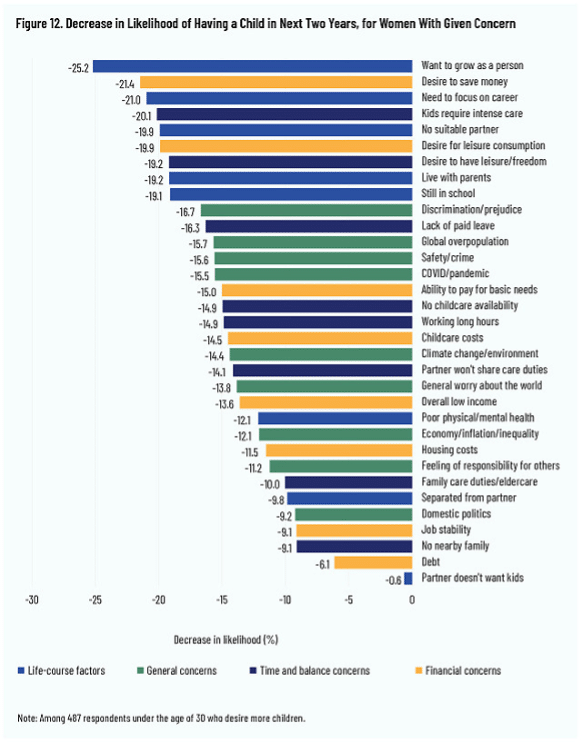August 8, 2023
Fertility Highs and Lows: Part 2,
Population Alarmism Myths and a Look at What the Future Might Hold
Alexis Goodman
Editor’s note: You won’t want to miss Part 1 of our series: “Fertility Highs and Lows: The Dark History of Population.” You can read it here.
As you read the various influential figure’s population concerns, it would be reasonable to wonder: “Isn’t there some truth to population alarmist fears? Can the world really sustain a population of eight billion people – and growing?”
Myth 1: There just isn’t enough physical space to sustain so many people on this planet.
Consider this fun fact: The entire population of the world could fit in the state of Texas. The population density would be equal to that of New York City. Yes, that would be one sprawling and massive city, but the rest of the world would still be available to produce food and the other necessities of life to support that population.
“On a global level, 50% of the world’s population lives on just 1% of its land.”
And look at this visual (to find more visuals like this one but providing different perspectives, from different countries, follow the link):

Put simply, “Half the world’s population lives in the yellow. The other half lives in the black.”
Myth 2: There isn’t enough food or natural resources to go around.
In his highly-popular 1968 book, The Population Bomb, Paul Ehrlich stated:
“The battle to feed all of humanity is over. In the 1970s the world will undergo famines–hundreds of millions of people will starve to death in spite of any crash programs embarked upon now.
Here we are some 50 years later and hundreds of millions of people did not starve. In fact, as the world’s population has grown, our capacity to feed people has only increased. Agriculture advances have completely changed the amount of harvest farmers bring in each year. Looking back on the 1970’s and 80’s, we are producing “hundreds of millions of tons more grain each year on tens of millions acres less land.”
Innovation, a “less is more” mentality, and unrestricted economies are what will give us the resources we need to support the populations we have. Just think of what changes and innovations we will be seeing ten years from now!
As our friends at Population Research Institute (PRI) tell us:
“Both of the world’s leading authorities on food distribution (the United Nations Food and Agriculture Organization [FAO] and the World Food Programme [WFP]) are very clear: there is more than enough food for everyone on the planet. The FAO neatly summarizes the problem of starvation, saying that “the world currently produces enough food for everybody, but many people do not have access to it.” Food is a lot like money: just because some people have none doesn’t mean that there isn’t enough of it–it’s just spread unevenly.”
As for the depletion of natural resources, read about the famous bet between the afore-mentioned Paul Ehrlich and economist Julian Simon. Simon argued that people are the “ultimate resource” and that humans would innovate their way out of resource shortages.
The obsession with supposed overpopulation takes attention off the real problems of delivering necessities such as food and education, improving infrastructure, reducing/eliminating corruption, and the lack of effective development and economy building.
Myth 3: Overpopulation causes poverty.
Once again, we turn to our friends at PRI:
“Essentially, the only way that poverty has ever been defeated, anywhere, is by infrastructures that humans have set up. So, when poverty does exist, it is when these infrastructures either 1) don’t exist, like in underdeveloped nations, or 2) are broken or have holes in them. Essentially, fixing poverty is about fixing bad infrastructure, not about eliminating people.
This is made obvious by the fact that the poorest nations in the world are often among the least populated. Take the Congo, for instance, which is one of the poorest countries in the world, with a meager per capita GDP of only $300. The Congo’s population density is only 75 people per square mile, a fairly light population density. Compare this with the Netherlands, one of the wealthiest countries in the world with per capita GDP of $39,200. The Netherlands has a population density of 1,039 people per square mile. (These numbers come from the CIA World Factbook.)”
It must be re-emphasized that population density and poverty do not go hand-in-hand. Reducing poverty is complicated and requires the world’s best efforts, but we error in not recognizing the incredible drop in global poverty. In 1970, about 60 percent of the 3.7 billion people living on this planet were still relegated to extreme poverty. Now, that figure is under 9 percent. “Today, one person escapes extreme poverty every second, thanks to better economic systems, improved knowledge, and cheaper technology in most areas of the world.”
The on-going impact of population alarmism
In 2021, the Pew Research Center did a survey for U.S. adults without kids aged 18-49, and they found 44% rated themselves as ‘not too likely’ and ‘not at all likely’ to have kids. Of those 44%, over half of them state their reasoning as, “They just don’t want to have children.
In contrast, The New York Times ran a survey, and their top results were childcare being too expensive, other financial concerns, and wanting more “me time.” Defendants of the low fertility rates state raising children in this economy is just too hard if not impossible.
They also cite, “women in particular pay an earnings penalty for having children,” because “for college-educated women in high-earning occupations: Children are particularly damaging to their careers.”
Fertility and Education
It is well documented as a country’s female population receives more education; their fertility rates drop. Because as Gary Becker, economist who did an analysis on the economic impact of children, explains, children are a product, and as a women’s education and opportunities increase, so does the cost for that product. It then becomes a question of whether or not they are willing to pay the price.
To counterbalance this, people are demanding more family friendly jobs, benefits, and incentives. “If you want us to have kids, you better make it easier for me” appears to be the mentality. But is that the solution to imploding fertility rates?
Consider Finland. Nordic countries are known for being the most gender inclusive and gender equal. Finland in particular offers paid parental leave after a birth for nine months. Until the child is of school age, public childcare is free for all children. But if the parents want to be there to see their children grow, they can do so and still receive a home care allowance up until the age of three. Couples with children also receive childcare and maintenance allowances.
A study analyzing the significant drop in first births among Finland citizens made some significant points. They concluded, “postponing or foregoing fertility within unions represents the primary reason for the fertility decline” and not much else. It wasn’t because their child benefits weren’t good enough. It’s that Finnish adults just don’t want kids.
They also recorded, “This projected decline is surprising, since the Nordic region previously featured a relatively high and stable cohort fertility, partly enabled by extensive social policy support provided by these countries intended to reconcile work and family life.”
The theory of “second demographic transition” (SDT) alleges, “changes to family formation patterns associate shifts in attitudes and norms towards greater individual autonomy and self-actualization”. The more family dynamics continue to be broken apart and people focus on themselves, fertility rates are going to continue to drop. With birth control and abortion so widespread, it continues to divorce the need for marriage and the desire for children.
As was stated previously, the higher educated a female population becomes, the less children she will have. Surprisingly, one study found in Denmark, Sweden, and Norway, “Ultimate childlessness has recently sharply increased among the less educated, and consequently, the educational gradient in childlessness among women has reversed.” It appears a “gotta get an education” attitude isn’t at the center of reasons for remaining childless.
The world is moving toward hyper-individualism and an ethic of self-centeredness is now the norm. We find the argument, “reliable contraception and greater availability of abortion have helped women delay marriage and childbearing, contributing to more experience of and appreciation for leisure time, and greater reluctance to invest in intensive mothering” to be at least one compelling explanation for falling fertility.
Other notable reasons for delaying children
There is significant research being done to show that mental health is another contributing factor to the falling fertility rates. As one study points out, “However, a diagnosis of a mental or behavioral illness had enormous effects: both men and women with mental or behavioral illness diagnoses saw their odds of childlessness triple vs. undiagnosed siblings.”
A Canadian study had women participate in surveys, stating their desired number of children, and then reported the actual number of children they had. Of the women that accomplished the number of children desired, they were overall happier than those that achieved a lower or higher number. And from that, the study learned that overall, women who achieved less children than desired had a lower life satisfaction than those who achieved more. This same study also concluded that women saw childbearing as a life achievement to engage in “after self-development is complete”.
Here is a visual of their findings from that study in Canada:

Note that financial constraints and reasoning are not at the top of the list of reasons women give for choosing not to have children.
The way forward
Our future progeny is at risk with movements like “Stop having Kids” and “I Regret Having Children,” and the cultivated belief that to not have access to contraceptives or abortion is oppression at its worst. It’s becoming imperative we change the way we view families and the way we let the government view people. Mary Meehan, in her book “The War on Population” states:
“In democratic theory, governments are made for people. Population control stands this principle on its head, so that people are made for the government and are treated mainly as components of the economy. Government tolerates them as long as they are productive; it even “makes investments” in them to improve their productivity. Viewing them as farmers view their cattle or sheep, it watches their breeding carefully and manipulates it in various ways.”
Governments should have a compelling interest in their citizens, but not to the extent they exert heavy-handed efforts in shrinking or enlarging families. Families are a fundamental unit of society, and we should be trying to restore our faith in marriage and family and a desire for children.
Governments would be better served to promote marriage and family, without the predatory language of producing or limiting children. Humanity is dependent on it. We should also shy away from forcing developing countries to institute “family planning” ideologies on their citizens. Sub-Sahara Africa’s fertility numbers are actually falling and these countries will more than likely never reach the population numbers the UN is projecting. The African nations would be wise to reject the advances of the West and not believe the lie that development can only occur if they suppress the births of African children.
More children are needed and wanted in this world, and contrary to popular belief, there is more than enough room for them. Currently 98 out of 103 countries with available data were initiating intrusive family planning policies. We must advocate for an end to this silent control of families by elitist groups and change the narrative of a self-obsessed society to one that is made complete by a family, no matter its size, and is not influenced by prevailing population and birth control dogmas.
Whether a couple chooses to utilize contraceptives is up to them, but women should not be made to feel that the only way to progress in the working arena is through denying herself motherhood. This isn’t true and it certainly shouldn’t be advanced in society. Before we can create more family friendly workplaces, we must change this prevailing mindset amongst women and encourage that to have a family is to find true purpose and completion in life.
Without that, we will find ourselves in a situation like Finland; paid for, yet empty daycares.
_________________________________________________________________

Alexis Goodman was raised on a ranch in Dadeville, Missouri. She loves spending time with her husband, reading, hiking mountains, and learning new hobbies. She is currently a student at Brigham Young University-Idaho, where she is working to get a degree in Political Science with an emphasis on American Government.

